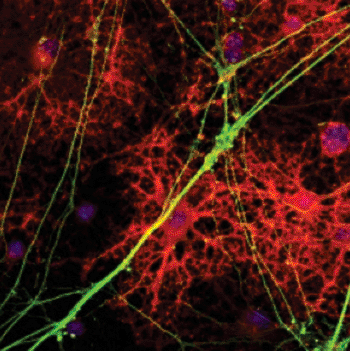Benztropine Reverses Multiple Sclerosis in Animal Models
By LabMedica International staff writers
Posted on 22 Oct 2013
Autoimmune disease researchers have reported the successful use of the Parkinson's disease drug benztropine [benzatropine (INN)] for treatment of animal models of multiple sclerosis.Posted on 22 Oct 2013
Benztropine is a centrally acting anticholinergic/antihistamine agent resulting from the combination of the tropine portion of the atropine molecule and the benzohydryl portion of diphenhydramine. It is used in patients to reduce the side effects of antipsychotic treatment, such as pseudoparkinsonism and dystonia. Benztropine is also a second-line drug for the treatment of Parkinson's disease. It improves tremor, but not rigidity and bradykinesia.

Image: This study showed that the drug benztropine led to the repair of multiple sclerosis-damaged nerve fibers in animal models (Photo courtesy of Dr. Luke Lairson, The Scripps Research Institute).
Progressive phases of multiple sclerosis are associated with inhibited differentiation of the progenitor cell population that generates the mature oligodendrocytes required for remyelination and disease remission. To identify selective inducers of oligodendrocyte differentiation, investigators at The Scripps Research Institute (La Jolla, CA, USA) performed an image-based screen for myelin basic protein (MBP) expression using primary rat optic-nerve-derived progenitor cells. They screened over 100,000 chemical compounds for any that could potently induce oligodendrocyte progenitor cells to differentiate.
The investigators reported in the October 9, 2013, online edition of the journal Nature that benztropine was among the most effective of the compounds that were screened. Furthermore, it significantly decreased clinical severity in the experimental autoimmune encephalomyelitis (EAE) model of relapsing-remitting multiple sclerosis when administered alone or in combination with approved immunosuppressive treatments for multiple sclerosis.
Evidence from a cuprizone-induced model of demyelination, in vitro and in vivo T-cell assays, and EAE adoptive transfer experiments indicated that the observed efficacy of the drug resulted directly from an enhancement of remyelination rather than immune suppression. Pharmacological studies indicated that benztropine functioned by a mechanism that involved direct antagonism of M1 and/or M3 muscarinic receptors.
“We are excited about these results, and are now considering how to design an initial clinical trial,” said senior author Dr. Luke L. Lairson, assistant professor of chemistry at The Scripps Research Institute. “We are also looking at some of the other, relatively unknown molecules that we identified in our initial screen, to see if any of those has better clinical potential than benztropine.”
Related Links:
The Scripps Research Institute







 assay.jpg)






